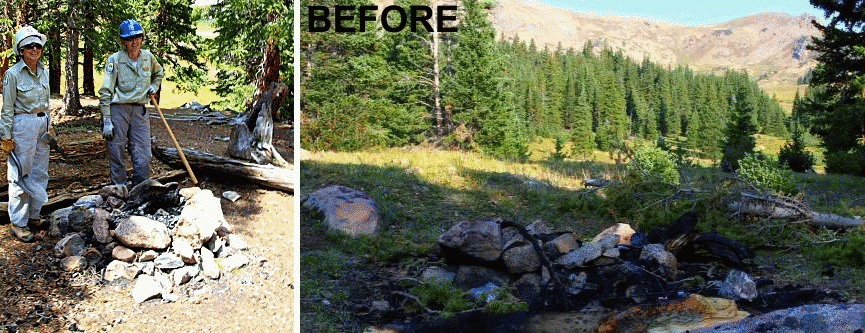TRAIL & CAMPSITE PROJECTS

The USFS recognizes the work that we do
"Working with partners such as ESWA is of utmost importance as we continue improving the sustainability of our trails system and maintaining the character of our precious Wilderness areas. As visitation to our district’s trails increases each year, we rely on partnerships to help complete high-priority projects such as these, and to provide quality visitor experiences to our guests."
Leanne Veldhuis
District Ranger
Eagle/Holy Cross Ranger District
White River National Forest

TRAIL & CAMPSITE MAINTENANCE
Our stewardship mission includes a commitment to help maintain our Wilderness trails and campsites. With picks, shovels, saws, and rock bars our volunteer trail crews repair damage, construct drainage improvements, install signage and remove illegal campsites. ESWA is the only volunteer group doing this much-needed work exclusively in our Wilderness Areas. Our group trail-maintenance projects are done on weekends during the summer hiking season. Coordinating with the Forest Service, ESWA runs two types of trail-maintenance projects: daytime and overnight pack-in projects.
1. Day Projects are generally conducted on a Saturday. Look at the Calendar on the home page of this website for upcoming projects and sign-up. Tools and safety equipment are provided. Volunteers bring their own lunch, plenty of water, and any other gear needed for a day on the trail. We generally work until mid-afternoon and conclude the day with tailgate refreshments provided by ESWA. ESWA has officially “adopted” the Deluge Lake trail out of East Vail so we do at least three half-day work days there each summer, as well as other work days on other trails both on the west side of the Eagles Nest Wilderness and the Holy Cross Wilderness.
2. Overnight pack-in/llama-supported projects
Recent News: This summer’s llama trips were fun and productive! Here are some stats for the accomplishments of our volunteers, Forest Service colleagues, and llamas Dominguez and Monte:
-
Slate Lakes: We cleared 102 fallen logs blocking the trail, and removed numerous illegal campfire rings. Photos HERE.
-
Lake Constantine: Despite foul weather, we installed a “No Campfires Above This Point” sign at 11,000 feet, cleared brush and logs from the trail, and removed over a dozen illegal campfire rings. Photos HERE.
-
Sopris-Brady Lakes: The team logged numerous campsites, blocking those too close to the lake, destroyed 20 illegal fire rings, and carried out 20 pounds of trash! Photos HERE.
REGISTRATION is necessary (contact Krista Hughes). Look at the Calendar on the Home page of this website for upcoming plans and sign-up. For these projects we typically hike to a campsite on Friday, do our trail work on Saturday and Sunday morning, and hike back out on Sunday afternoon. This format enables us to work much deeper in the wilderness than a day project would allow. All of our tools, heavier camping gear and common refreshments are packed into the campsite by our llamas, Dom and Powell. Volunteers supply their own camping gear and food. ESWA supplies common snacks and liquid refreshments.
Wilderness regulations limit our volunteer work parties to groups no larger than 15 people. For day projects, we can handle more people by splitting up into smaller groups. This is not possible for our pack-in projects, so reservations are required to participate in pack-in projects. No special training is required.




A Typical Backcountry Trip with Llamas
Dave Brewster
The ESWA llama trips offer great opportunities to explore some of the beautiful more remote areas of the wilderness with experienced backpackers and help restore some these harder-to-reach areas. Two US Forest service rangers guide the trips and they may make changes due to conditions (snow pack, water level at stream crossings,…). Typically, we backpack in on Friday (usually 5-7 miles) and set up camp away from the more heavily used areas near the lakes. The llamas often have extra capacity and may carry some of our gear (sleeping bag or tent) as well as tools and protective equipment we need. The llamas walk steadily, but not fast. People generally hike at their own pace with one of the rangers arriving early to mark the camping area not far from a water source. Personal water purifiers (filters) are needed. We are all responsible for our own food, cooking/eating gear, and camping equipment. The forest service has bear-proof containers if you need one which we hang away from our tents at night. We practice Leave No Trace camping so we don’t build campfires, but we generally eat together. ESWA also brings some happy hour supplies for everyone. In addition they give out individual WAG bags instead of digging a pit toilet. The llamas carry the WAG bags back. The following morning, after breakfast and packing lunch, information about possible hazards and proper use of the tools is presented. Then we usually hike up the trail and break into smaller groups to do various restoration activities. These might include scattering illegal fire rings and restoring the area, restoring illegal campsites (typically on lakeshores), trail maintenance (erosion control, trimming vegetation, …), pulling noxious weeds, and repairing and adding signage. Everyone works at their own pace and we are urged to take frequent breaks and drink lots of water. We return to camp in the late afternoon to enjoy the wilderness and each other’s company. The following day is spent mainly backpacking out. Sometimes there is an opportunity to do some additional work for those interested.


When visitors fail to follow Leave No Trace practices, our TRACERASER crews get to work - here on illegal campfire rings

